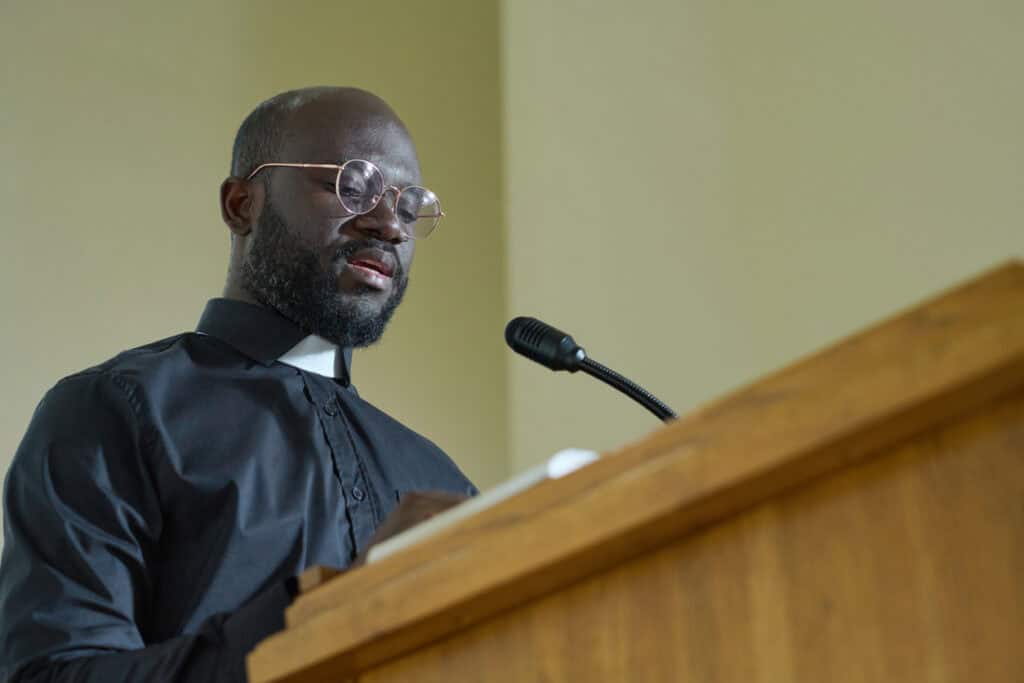The journey to becoming a church of missionary disciples
Stages, signposts and helpful resources to use together as a church
AS INDIVIDUALS AND AS A church family, it may seem like a big step to start sharing our faith with those in our day to day lives who don’t have faith. But in the process of growing in confidence as missionary disciples, we can take smaller steps along the way.
Many of us have a strong internal faith but lack the confidence to talk about it with others. But as we spend time with Jesus through worship, fellowship and prayer, the Holy Spirit will ‘send us out’ into our daily lives to share the Good News we have discovered for ourselves.
This can be a daunting prospect and a process of change for individuals and your church as a whole. Church leaders and congregations across the country (that is to say, worshipping communities, chaplaincies, Fresh Expressions and many others) say that one of the biggest barriers to living and sharing faith in everyday life is confidence.
And this isn’t unique to ‘ordinary’ people in congregations: clergy can feel this way too, and churchwardens and lots of people who are otherwise devoted to God.
So how might church leaders enable everyone to think about how our faith impacts us in all parts of our lives, and to live our lives accordingly?
It doesn’t need to happen all at once – there are stages of reflection and preparation:
Exploring
This stage seeks to address lack of confidence with two sets of questions:
1. Canterbury’s Changing Lives conversations
This is two questions to use in small groups, with committees (including PCCs), and even with congregations as confidence grows. These two questions are designed to encourage people to think about where God is working in their lives and what difference it makes to them. They are:
- How is God/Jesus changing your life right now?
- How can we support each other to be seven-day-a-week disciples?
See resources to help start these conversations below.
2. Bath & Wells’ everyday questions
These 40 questions address topics from belief to science. They work well with groups who may be earlier on their faith journey, or less confident in speaking about their faith. The questions give people the opportunity to think about ordinary issues that all of us face on a daily basis, and they can be explored to think about how our faith might shape our responses. These have been popular with children and young people as well as adults.
You can download the questions under the Resources section below.
How long will this stage take?
We suggest a pattern to noticing change that follows:
- Imagine. What changes would you like to see, hope to see, dream of seeing!? Have you noticed any changes in people’s conversations, levels of trust and openness, more outward reflection on their faith journey?
- Identify. What have you seen or heard that is different in what – or who – people are praying for? How do people respond to the questions initially? How do they respond after a month, or longer?
- Insights. What does this show you about the ways in which your culture is changing? What have you learnt that works well in your context to begin conversations about everyday faith? What needs to be done next, or to help strengthen this?
Ask these questions before you start using the resources. Check in again after a couple of months, and again at six months. If you’re noticing the changes you want to see – great! You’re ready to move on to the next stage. If you’re not yet seeing these changes, or you’re just starting to see some, don’t worry – every church (and every individual) is in a different place on their spiritual journey. The ‘How to’ guide for the Changing Lives Conversations has suggestions about how and where you can try these questions. And, above all, don’t forget to pray!
Enabling

At this stage, leaders will look at small changes which can be made in the life of the church to help people think about their faith beyond the church building. It’s about including everyday life in our prayers, celebrating the work and service that our congregations do on a daily basis, and equipping people through sermons and liturgy to think about how our faith can and does impact others for the best in all parts of our lives.
Eight Shifts
There are eight shifts that churches can try. Each shift has a key question, a key practice, a story from someone who has tried the shift, and a link to Faith at Home to support young people in their everyday faith. Each shift is complementary, so we can do more than one at a time. You can access the Eight Shifts download below.
How long will this stage take?
It is expected this stage will last around 6-8 months. This will of course vary in individual contexts, and it will also depend on how many of the shifts you and your church try.
What changes should we look out for?
As you begin these shifts, it can help to think through what you hope will change, so you can notice if it happens. There are three things to be aware of:
- Attitudes and actions. Have you noticed any changes in people’s conversations, levels of trust and openness, a more outward reflection on their faith journey? Are people talking about a difference in confidence around faith?
- Issues and priorities. Have you noticed any changes in the issues people consider to be important? Are you discussing different things, or discussing things differently on your PCC? Is there a difference in what, and who, you are praying for?
- Groups and networks. Are people suggesting new ways of meeting or organising the life of the church? Have people mentioned networks and groups they are interested in that support faith in the whole of life?
The Church Development Tool (details below) is also now available to measure a starting point for discipleship and help you track progress as you grow together.
Track your progress
As well as making some of these small shifts, the Church Development Tool is now available to measure a starting point for discipleship. Find out more about it on the Church of England website.
Resources to help
Related resources
Outdoor church grows in the glory of God’s wonderful creation
Launching successful worshipping communities
Your secret weapon: the grandparent generation
Running successful children and youth ministry








